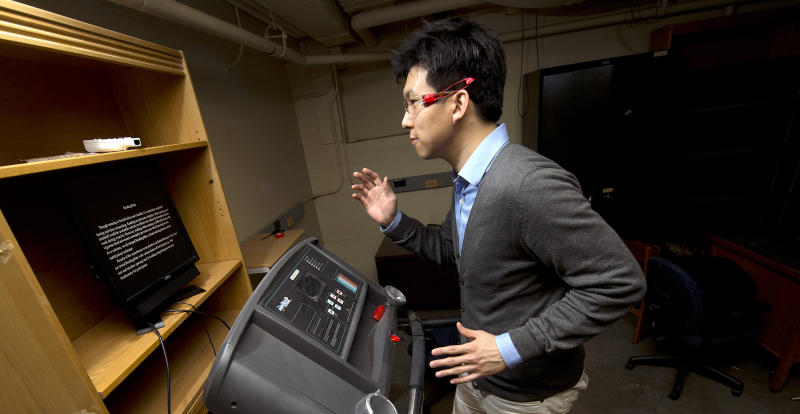
A new innovation allows treadmill users to work their bodies and brains at the same time. The system, called ReadingMate, adjusts text on a monitor to counteract the bobbing motion of a runner's head so that the text appears still, said Ji Soo Yi, an assistant professor of industrial engineering at Purdue University.
 "Not many people can run and read at the same time," said Yi, working with doctoral candidate Bum chul Kwon. "This is because the relative location of the eyes to the text is vigorously changing, and our eyes try to constantly adjust to such changes, which is burdensome."
"Not many people can run and read at the same time," said Yi, working with doctoral candidate Bum chul Kwon. "This is because the relative location of the eyes to the text is vigorously changing, and our eyes try to constantly adjust to such changes, which is burdensome."
The small font size in text adds to the difficulty.
"You could increase the font size and have a large-screen monitor on the wall, but that's impractical because you cannot have numerous big screen displays in an exercise room," Yi said.
The researchers developed ReadingMate on the hypothesis that the primary impediment to reading while running is the head's vertical movement. The new system allows a treadmill user to read normal-size text on a small monitor mounted in front of the machine.
Findings appear online this month in Human Factors: The Journal of the Human Factors and Ergonomics Society. The paper was authored by Kwon, Yi and Yu Zhu, an associate professor of statistics.
The study included 15 students, who carried out a "letter-counting" task while running on a treadmill and using ReadingMate. The test requires participants to count how many times the letter F occurs in two lines of text situated among 10 lines displayed on a computer monitor.
The user wears goggles equipped with infrared LEDs, and an infrared camera captures the LEDs, tracking the runner's bobbing head. Then the text is moved in unison with the head movement, taking into consideration the human reflex to compensate for motion.
"Our eyes can accommodate vibration to a certain degree," said Yi, director of Purdue's Healthcare and Information Visualization Engineering Lab, or HIVE. "There are compensatory reflex mechanisms that tend to stabilize the head and eyes to maintain gaze and head position."
Kwon led work to create an algorithm to correctly move the text, accounting for this reflex.
"You can't just move the text exactly in synch with the head because the eye is already doing what it can to compensate," he said. "So you have to account for that compensation by moving the text slightly out of synch with the head motion."
The research showed a higher accuracy for people who used ReadingMate compared to those in a control group.
"We also measured whether participants gave up on counting the letters because the task was too difficult," Kwon said. "We often saw people giving up without ReadingMate, especially with certain font sizes and smaller spaces between lines."
The system also might be used by heavy equipment operators and aircraft pilots.
"Both may experience heavy shaking and turbulence while reading information from a display," he said. "ReadingMate could stabilize the content in such cases."
Zygmunt Pizlo, a professor in the Department of Psychological Sciences, provided critical advice during preliminary investigations, and industrial engineering student Yuming Zhang assisted post-experiment data analysis. Doctoral Student Han Wu in the Department of Statistics also was involved in the research.

 Previous page
Previous page Back to top
Back to top







